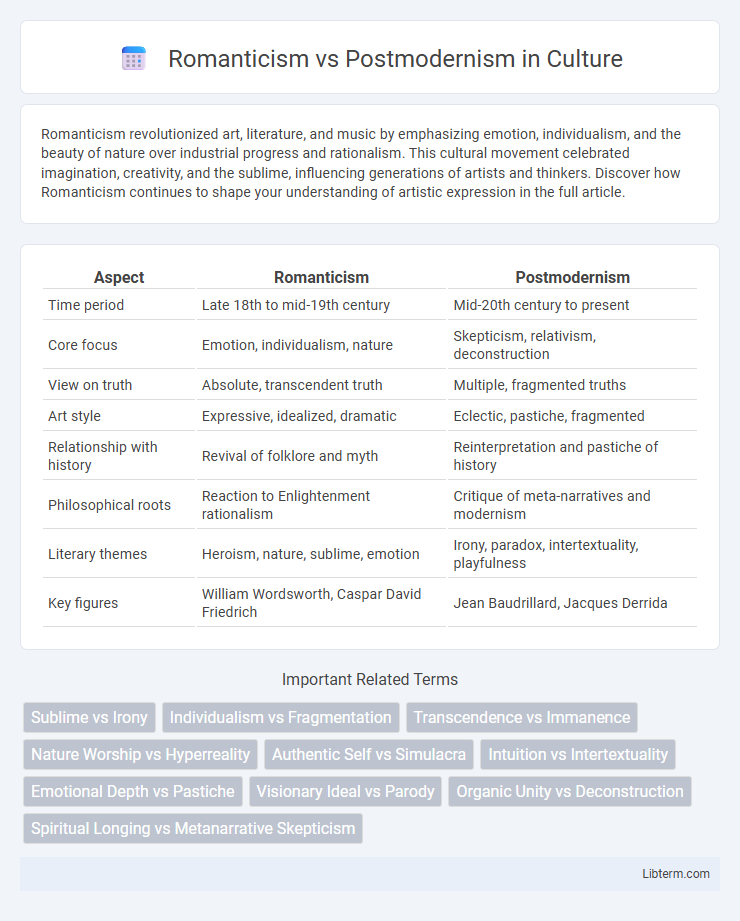Romanticism revolutionized art, literature, and music by emphasizing emotion, individualism, and the beauty of nature over industrial progress and rationalism. This cultural movement celebrated imagination, creativity, and the sublime, influencing generations of artists and thinkers. Discover how Romanticism continues to shape your understanding of artistic expression in the full article.
Table of Comparison
| Aspect | Romanticism | Postmodernism |
|---|---|---|
| Time period | Late 18th to mid-19th century | Mid-20th century to present |
| Core focus | Emotion, individualism, nature | Skepticism, relativism, deconstruction |
| View on truth | Absolute, transcendent truth | Multiple, fragmented truths |
| Art style | Expressive, idealized, dramatic | Eclectic, pastiche, fragmented |
| Relationship with history | Revival of folklore and myth | Reinterpretation and pastiche of history |
| Philosophical roots | Reaction to Enlightenment rationalism | Critique of meta-narratives and modernism |
| Literary themes | Heroism, nature, sublime, emotion | Irony, paradox, intertextuality, playfulness |
| Key figures | William Wordsworth, Caspar David Friedrich | Jean Baudrillard, Jacques Derrida |
Defining Romanticism: Origins and Core Principles
Romanticism emerged in the late 18th century as a reaction against the Enlightenment's emphasis on reason and industrialization, prioritizing emotion, individualism, and nature's sublime beauty. Its core principles include the celebration of artistic creativity, intuition, and the valorization of personal experience over classical forms and societal norms. This movement profoundly influenced literature, art, and philosophy by championing imagination and emotional depth as essential to human understanding.
Understanding Postmodernism: Key Characteristics
Postmodernism challenges the Romantic emphasis on emotion and individualism by embracing skepticism toward grand narratives and objective truths. It features fragmented structures, intertextuality, and a playful blending of genres to question established meanings and cultural norms. Central to postmodern thought is the idea that reality is socially constructed, highlighting diversity, pluralism, and the instability of identity.
Historical Contexts: From 18th Century to Late 20th Century
Romanticism emerged in the late 18th century as a reaction against the Industrial Revolution and the Enlightenment's emphasis on reason, emphasizing emotion, nature, and individualism. Postmodernism arose in the late 20th century, critiquing modernist ideals by questioning grand narratives, embracing skepticism, and highlighting cultural relativism amidst rapid technological and social changes. Both movements reflect their distinct historical contexts: Romanticism responding to industrialization and rationalism, while Postmodernism addresses the fragmentation and uncertainty of the post-World War II era.
Notable Figures: Influential Authors and Artists
Romanticism featured influential figures such as William Wordsworth, Mary Shelley, and Caspar David Friedrich, whose works emphasized emotion, nature, and individualism. In contrast, Postmodernism includes key authors and artists like Jean Baudrillard, Thomas Pynchon, and Cindy Sherman, known for their exploration of skepticism, fragmentation, and media critique. These notable figures exemplify the cultural shifts between the emotional depth of Romanticism and the critical deconstruction characteristic of Postmodernism.
Artistic Expression: Style and Aesthetics Compared
Romanticism emphasizes emotional intensity, individual creativity, and nature's sublime beauty through dramatic, vivid imagery and expressive brushwork. Postmodernism rejects singular narratives and embraces eclectic styles, irony, and pastiche, blending high and low culture with playful, fragmented aesthetics. While Romanticism seeks authenticity and transcendence, Postmodernism often questions originality and embraces ambiguity in artistic expression.
Individualism and Subjectivity in Both Movements
Romanticism emphasizes intense individualism and subjective emotional experience as a reaction against Enlightenment rationalism, celebrating personal intuition and inner feelings. Postmodernism also highlights subjectivity but challenges fixed identities and universal truths, promoting fragmented, multiple perspectives and skepticism towards grand narratives. Both movements underscore the importance of personal experience, yet Romanticism affirms a unified self while Postmodernism deconstructs the notion of a coherent individual identity.
Attitudes toward Reason, Nature, and Reality
Romanticism emphasizes intuition, emotion, and the sublime beauty of nature as sources of truth, often rejecting the strict rationalism of the Enlightenment. Postmodernism challenges the notion of a singular, objective reality, embracing skepticism toward grand narratives and questioning established concepts of reason and nature. While Romanticism celebrates the idealized natural world, postmodernism views nature and reality as socially constructed and contingent on language and power structures.
Approaches to Truth and Narrative Structure
Romanticism emphasizes subjective truth and emotional authenticity, often presenting nature and individual experience as sources of universal meaning, while its narratives follow linear, heroic, and idealized structures. Postmodernism challenges the existence of absolute truths, promoting relativism and skepticism, with fragmented, non-linear, and self-referential narrative forms that question the reliability of language and authorship. These contrasting approaches reveal Romanticism's faith in coherent, meaningful storytelling versus Postmodernism's embrace of ambiguity and multiplicity in truth and narrative.
Cultural Impact: Literature, Art, and Philosophy
Romanticism emphasized individual emotion, nature, and the sublime, influencing literature with poets like Wordsworth and artists such as Turner who celebrated imagination and intuition, while its philosophical roots in idealism shaped perceptions of self and reality. Postmodernism challenged traditional narratives and absolute truths, impacting literature through metafiction and pastiche, art via deconstruction and mixed media, and philosophy by questioning meta-narratives and embracing relativism. The cultural impact of Romanticism cultivated a reverence for subjective experience, whereas Postmodernism fostered critical skepticism and plurality in interpreting truth and meaning.
Lasting Legacies: Influence on Contemporary Thought
Romanticism's lasting legacy lies in its emphasis on individual emotion, nature, and the sublime, shaping contemporary ideas about personal expression and ecological awareness. Postmodernism challenges universal narratives and objective truths, influencing modern critical theory, art, and cultural relativism. Together, these movements continue to inform debates on subjectivity, identity, and the role of history in shaping human experience.
Romanticism Infographic

 libterm.com
libterm.com